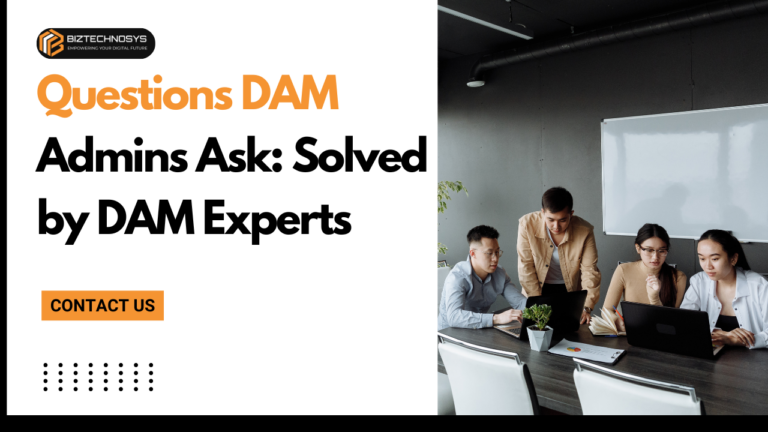
Questions DAM Admins Ask often begin with the basics—like what DAM actually stands for. DAM stands for Digital Asset Management. It refers to the processes and systems used to store, organize, retrieve, and distribute digital assets such as images, videos, audio files, documents, and other multimedia content. A DAM system helps businesses manage their digital content efficiently and ensures that the right people have access to the right files at the right time.
A DAM tool or digital asset management system is used for centralizing the storage of digital assets. It helps streamline content workflows, maintain brand consistency, enable easy search and retrieval, and manage permissions for asset access. DAM tools are especially useful for marketing teams, creative teams, and large enterprises that deal with vast amounts of content. Popular DAM products include Acquia DAM, Bynder, Widen, and Adobe Experience Manager.
In business, DAM (Digital Asset Management) plays a vital role in managing brand assets, improving collaboration, reducing content production costs, and speeding up time to market. Businesses use DAM systems to:
Ensure consistent brand messaging
Provide secure access to files
Track asset usage and performance
Automate workflows and approvals
Support product information management
A robust digital asset management system is an integral part of a company’s digital experience platform, working alongside content management systems and customer data platforms.
Continue reading about 3 Reasons to Improve Web Accessibility with this link.
DAM is used for organizing and distributing digital content. It allows companies to:
Tag and categorize assets for easy searchability
Share content across teams and departments
Support content localization and personalization
Integrate with design tools and CMS platforms
Maintain compliance with licensing and usage rights
Use cases span across marketing campaigns, e-commerce product catalogs, social media content, and more.
Continue reading about What is Sitecore Content Hub One? with this link.
For new DAM admins, the world of digital asset management can be overwhelming. Here’s a quick breakdown of your responsibilities:
Learn your DAM platform’s features (e.g., Acquia DAM, Adobe DAM)
Understand how assets are organized (folders, metadata, tags)
Manage permissions and user roles
Support users in uploading and retrieving content
Monitor system performance and usage metrics
We recommend taking a DAM admin course or exploring your vendor’s product documentation and training modules. Your goal is to enable seamless digital content management for your organization.
As your organization grows, so will your DAM users. You can support new user groups by:
Setting up roles and permissions to control asset access
Creating user-specific portals or collections to simplify navigation
Developing onboarding guides and training resources
Utilizing integrations with tools your new users already use (e.g., Slack, SharePoint, or CMS platforms)
Invest time in understanding each user group’s content needs and use your DAM’s features to personalize the experience accordingly.
Mergers and acquisitions introduce complex challenges, especially for DAM systems. Here’s how to approach it:
Conduct a system audit: Understand both systems’ metadata structures, file types, and usage workflows
Choose a primary platform: Decide which DAM system to retain or if a hybrid approach is needed
Migrate assets systematically: Map metadata, deduplicate files, and preserve folder hierarchies
Engage stakeholders early: Coordinate with IT, marketing, legal, and creative teams
Document everything: From asset ownership to licensing and tagging structures
If you’re using platforms like Biztechnosys, take advantage of cloud-based scalability and security.
Continue reading about What is Sitecore 360? How Can It Benefit Your Business? with this link
Absolutely. A DAM system doesn’t exist in isolation. Integrations amplify the value of your DAM by connecting it with:
Content Management Systems (CMS): WordPress, Drupal, Sitecore
Creative tools: Adobe Creative Cloud, Canva
Product Information Management (PIM): Sync product data and media assets
Marketing Automation Platforms: HubSpot, Marketo
Customer Data Platforms (CDP): Enable personalized asset delivery
Integrations enable automation, improve team productivity, and ensure content consistency across platforms. Think of DAM as the hub of your content management ecosystem.
Being a DAM admin is both strategic and operational. To grow in your role:
Take a DAM admin course: Enhance your understanding of DAM full form in database, metadata best practices, taxonomy, and workflows
Stay updated on DAM system examples and innovations: Tools like Acquia DAM and Widen constantly evolve
Focus on user experience: Make asset retrieval intuitive
Create a product roadmap: Collaborate with stakeholders to outline DAM upgrades, new features, and user training
Track DAM performance: Use analytics to optimize content usage, streamline uploads, and improve findability
DAM is at the heart of digital experience, and with the rise of cloud platforms and digital asset management software, businesses can scale their operations effectively.
In today’s digital-first world, having a reliable and flexible digital asset management platform is essential. DAM admins play a crucial role in ensuring smooth operations, facilitating collaboration, and maximizing the return on digital assets.
Whether you’re working with image DAM, video content, or brand assets, your efforts as a DAM admin impact how efficiently your organization operates. By mastering tools, processes, and best practices, you can build a scalable and powerful DAM management system that supports your business goals.
Keep asking questions, keep learning, and remember—your DAM journey is just beginning.
Continue reading about How to Choose a Sitecore Development Partner with this link.

We are your Strategic IT Partner in development of reliable and scalable IT solutions for any OS, browser and device. We bring together deep industry expertise and the latest IT advancements to deliver custom solutions and products that perfectly fit the needs and behavior of your target audience.
Skype :: biztechnosys
AUS :: +61 4684 88455
INDIA :: +918035827097
Email :: info@biztechnosys.com
Copyright © 2012 – 2025 BIZTECHNOSYS. All Rights Reserved.